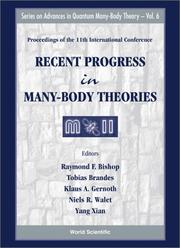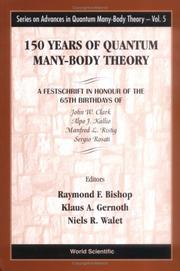| Listing 1 - 4 of 4 |
Sort by
|

ISBN: 1281929816 9786611929817 9812777849 9789812777843 9810248881 9789810248888 9781281929815 6611929819 Year: 2002 Publisher: Singapore River Edge, NJ World Scientific
Abstract | Keywords | Export | Availability | Bookmark
 Loading...
Loading...Choose an application
- Reference Manager
- EndNote
- RefWorks (Direct export to RefWorks)
Quantum many-body theory as a discipline in its own right dates largely from the 1950's. It has developed since then to its current position as one of the cornerstones of modern theoretical physics. The field remains vibrant and active, vigorous and exciting. Its most powerful techniques are truly universal. They are constantly expanding to find new fields of application, while advances continue to be made in the more traditional areas. To commemorate the impending 80th birthdays of its two co-inventors, Firtz Coester and Hermann Kümmel, one such technique, namely the coupled cluster method, w
Many-body problem --- Quantum theory. --- Quantum dynamics --- Quantum mechanics --- Quantum physics --- Physics --- Mechanics --- Thermodynamics
Book
ISBN: 1283234963 9786613234964 9814340790 9789814340793 9789814340786 9814340782 Year: 2011 Publisher: Singapore Hackensack, NJ World Scientific
Abstract | Keywords | Export | Availability | Bookmark
 Loading...
Loading...Choose an application
- Reference Manager
- EndNote
- RefWorks (Direct export to RefWorks)
The orientation and physical context of the CMT Series of Workshops have always been cross-disciplinary, but with an emphasis placed on the common concerns of theorists applying many-particle concepts in diverse areas of physics. In this spirit, CMT33 chose to focus special attention on exotic fermionic and bosonic systems, quantum magnets and their quantum and thermal phase transitions, novel condensed matter systems for renewable energy sources, the physics of nanosystems and nanotechnology, and applications of molecular dynamics and density functional theory.

ISBN: 1281951331 9786611951337 9812799761 9789812799760 9789810247300 9810247303 Year: 2001 Publisher: Singapore River Edge, NJ World Scientific
Abstract | Keywords | Export | Availability | Bookmark
 Loading...
Loading...Choose an application
- Reference Manager
- EndNote
- RefWorks (Direct export to RefWorks)
In July 2000 a conference was held to honour the 65th birthdays of four of the leading international figures in the field of quantum many-body theory. The joint research careers of John Clark, Alpo Kallio, Manfred Ristig and Sergio Rosati total some 150 years, and this festschrift celebrated their achievements. These cover a remarkably wide spectrum. The topics in this book reflect that diversity, ranging from formal aspects to real systems, including nuclear and subnuclear systems, quantum fluids and solids, quantum spin systems and strongly correlated electron systems. The book collects more
Book
ISBN: 1283899922 9812792759 9789812792754 Year: 2000 Publisher: Singapore World Scientific
Abstract | Keywords | Export | Availability | Bookmark
 Loading...
Loading...Choose an application
- Reference Manager
- EndNote
- RefWorks (Direct export to RefWorks)
Quantum many-body theory as a discipline in its own right dates largely from the 1950's. It has developed since then to its current position as one of the cornerstones of modern theoretical physics. The field remains vibrant and active, vigorous and exciting. Indeed, its successes and importance were vividly illustrated prior to the conference by the sharing of the 1998 Nobel Prizes in both Physics and Chemistry by three many-body theorists. Two of those Nobel laureates, Walter Kohn and Bob Laughlin, delivered invited lectures at this meeting, the tenth in the series of International Conferenc
| Listing 1 - 4 of 4 |
Sort by
|

 Search
Search Feedback
Feedback About UniCat
About UniCat  Help
Help News
News